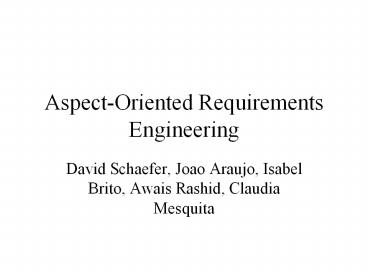Aspect-Oriented Requirements Engineering - PowerPoint PPT Presentation
1 / 12
Title:
Aspect-Oriented Requirements Engineering
Description:
David Schaefer, Joao Araujo, Isabel Brito, Awais Rashid, Claudia Mesquita. Problems ... How to model aspects at the requirements level? ... – PowerPoint PPT presentation
Number of Views:25
Avg rating:3.0/5.0
Title: Aspect-Oriented Requirements Engineering
1
Aspect-Oriented Requirements Engineering
- David Schaefer, Joao Araujo, Isabel Brito, Awais
Rashid, Claudia Mesquita
2
Problems
- How to identify aspects at the requirements
level? - What is the relationship between aspects and
non-functional requirements, constraints and
concerns? - How to model aspects at the requirements level?
- How to trace requirements level aspects through
later development stages and during
re-engineering? - How to validate aspects identified at the
requirements level?
3
Identifying Aspects (1)
- Solution 1 Model using viewpoints/use
cases/scenarios/stakeholder concerns and then
identify crosscutting requirements. - Exploit the power and potential of existing
mechanisms - - Scalability problems. Hard to observe
crosscutting in the presence of a large number of
viewpoints, use cases or scenarios. - Int Easier to see the functional crosscutting
against a base SOC - Int Adapt existing techniques.
4
Identifying Aspects (2)
- Solution 2 Brainstorming without the modelling.
- No effort required for initial structuring
- - You could be absolutely list brainstormed!
- - You are bound to miss something
- Int You could find aspect you might not find
using other techniques
5
Identifying Aspects (3)
- Solution 3 Look at global properties,
non-functional requirements and constraints as
they are potential aspects - Easier to spot
- Int Might not necessarily be global
6
Modelling Aspects (1)
- Solution 1 Extension of existing modelling
mechanisms e.g. OO, FSM, Concern-based - Ride the power of existing techniques
- Ease of integration with existing techniques,
tools, etc. - Ease of learning
- - Inherit the shortcomings of existing techniques
7
Modelling Aspects (2)
- Solution 2 Express them as requirements affected
by multiple concerns in a concern graph. The
edges of the concern graph express satisfaction
of requirements by certain other entities. - No modelling restrictions gt greater
flexibility - - Difficult to integrate with other techniques
- - Higher maintenance costs
- Int Complex structure might make it difficult to
identify an aspect
8
Traceability (1)
- Solution 1 Concern graph developed through
stepwise concretisation of concerns. The leaves
of the graph are the code and in between are
other documents such as design. - Good traceability
- - Maintenance and scalability
- Int Development time is a question of evaluation
in real world systems development
9
Traceability (2)
- Solution 2 Re-engineering Tool to find aspects
in your code. Some form of code mining and
extract patterns of crosscutting. - Tool support
- - Effort to develop a tool
- Int Accuracy
- Solution 3 Guidelines for the mapping and
influence of aspects to later stages perhaps
influenced by domain analysis. - Early identification of traceability
- - Need really good guidelines otherwise mistakes
are likely
10
Validation (1)
- Solution 1 Prototyping
- Intensive participation of stakeholders at an
early stage - - Things can be missed
- Solution 2 Formal methods
- Precision
- - Doesnt mean it is correct
- - Hard to obtain input from stakeholders
- - Can be complicated an expensive
11
Validation (2)
- Solution 3 Domain analysis
- Domain constraints taken into account
- - Hard to generalise
- Solution 4 Early architecture development (in
parallel with requirements modelling) - Early exchange of information between
architecture and requirements design - Int Decision on architecture may be too early
12
Conclusion
- Need a systematic process to identify, model and
validate concerns - Exploit existing mechanisms for backward
compatibility, their existing user base and power - Scalability and traceability are critical
- Validation is extremely important though hard to
achieve - Domain analysis and stepwise development has an
important role to play































